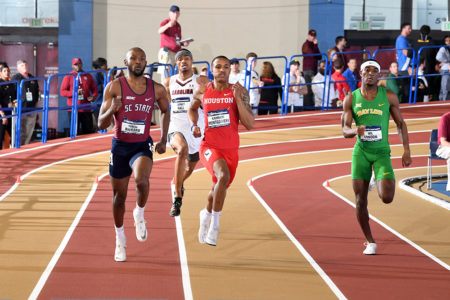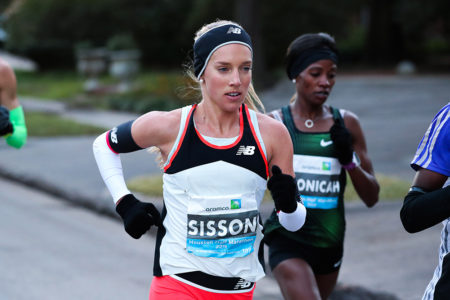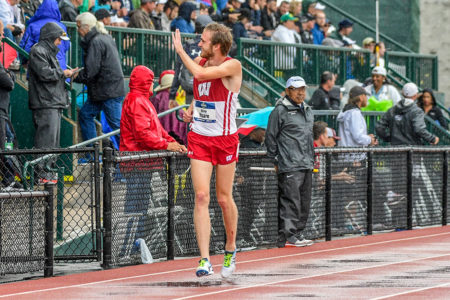
THE POWERS THAT BE have thrown a changeup at the track world this year, scheduling the World Championships late-late-late. Distance runner Emily Sisson has made the most in the first quarter of the anomalous ’19 calendar with a jump to No. 2 on the U.S. all-time half-marathon list and now—at the Stanford Invitational—to No. 3 in the 10,000. With the California track win, Sisson became the first American to score a Tokyo Olympic qualifying mark; these are not easy to come by. She plans to cap her spring with a marathon debut in London on April 28.
Sisson, 27, opened her competitive year in January with a 5th-place run in the Houston Half, breaking up what otherwise would have been a sweep of the first 8 places by East African stars. Gladys Cherono, the 6th-placer behind Sisson, won the World Championship at the distance in ’14. Of perhaps greater monument, though, was Sisson’s time, 67:30, a 51-second PR and second among Americans only to her training partner Molly Huddle’s 67:25 AR from ’18.
“I was training really well up to Houston,” Sisson says. “Then after Houston I took an easy week and kind of ran every other day. Then after that I got into marathon training. But I still had that base going into the marathon buildup from having those good few months of training leading up to Houston. So I’ve been pretty lucky with the past few months of getting in some consistent training.” Training that is paying off, that is. Sisson and Huddle trained in Arizona over the winter, Sisson in Scottsdale with husband-since-October Shane Quinn pacing many of her workouts. Huddle ground out her preparation at altitude in Flagstaff.
The Stanford 10K, per coach Ray Treacy’s plan for Sisson and Huddle (who’s also on the London Marathon entry list), was a standard step in the set piece. “We did want a race before London,” Sisson says, “and the timing of this just worked out well. And I was like, ‘Well, since we’re going there, why don’t we try to get something out of it?’ So the Worlds standard and the Olympic standard were both goals that we had. But we also weren’t entirely sure how we were going to feel coming off marathon training. So we were like, ‘This is what we want to do but we’re going to be a bit flexible on the day because we just don’t know how our bodies are going to feel out there.’
“We’ve been just doing so much training. I personally felt pretty strong from all the miles but I’m like, ‘I might feel really tired, I don’t know.’ So we just talked before the race and were like if one person’s feeling a little better we’ll just talk to each other during the race and just figure it out. But our plan going in was just to take turns leading every mile or so.” As the laps spun by on a cool Northern California evening, Sisson and Huddle sensed a quick time was in the cards. “I felt pretty good so my goals kind of changed a bit throughout the race,” Sisson says. “I realized after a little while that 31:25 [the Olympic standard] was very doable. So I was like, ‘OK, let’s shoot for 31:10 now.’ And then with a few laps to go I was feeling really good and I was like, ‘Alright, let’s try to break 31:00.’ But going in, 31:25 was our A goal and B was the Worlds standard.”
Sisson kicked the last two circuits and finished in 30:49.57, 36.07 faster than her previous best, from the ’17 USATF Champs race. “Yeah, I guess it was a successful trip,” she says. “So now we just have 3 weeks until London.” She has fared well in training on her first pass through a marathon buildup. “My long runs are longer than they were before and everything is just a bit more,” she says. “My doubles are longer, my workouts are a little longer. So it’s less work on the track and more like longer interval work, and longer tempos and everything. Yeah. But it wasn’t a huge, drastic change. I think I’m just comparing it to what I hear other marathoners, the kind of miles that they do. Mine never got as high as what I’ve heard other people do. I still did increase a lot. I used to do like 90M [c145km] a week, and I’m between like 110 and 120 [c175–195], somewhere in there.” (continues)
Although their workout schedules haven’t meshed much recently, Huddle’s marathon experience has informed Sisson’s run at tackling the long road distance. “Molly does a little bit more than me, but this is also her fourth marathon—because she did New York twice and Boston,” Sisson says. “So she has more experience than me and she kind of has figured out what works for her at this point, whereas this is my first one. So we don’t really know what works.
“It’s going to be a lot of learning in this buildup and this race. Just ’cause it almost feels like a different sport to me, the way the training is laid out. It’s way less trackwork. That’s what feels like the biggest difference. It’s just not that much stuff on the track and not that much fast interval work.” In the post-Stanford week the two got together for a weekly long run. “It was the first time that our long runs fell on the same day,” Sisson says, “so we did it together and both of our husbands were there giving us bottles every 4M [c6.5km] or something.”
As Sisson sees it, the late Worlds this year offered an opportunity. “The timing just worked out for London,” she says. “Going into the Olympic year, it’s like this gives me the best chance to see how I do in the marathon, if that’s something I want to pursue in 2020, or if the timing’s not right yet and I want to go back to the 10K and focus on that.”
Still, the marathon, as any runner can attest, is its own animal. “I’ve never run the distance,” Sisson says. “We haven’t talked race specifics yet but it is a fast course. I would like to run a fast time on that as well. That is the goal, to try to run a good, quick first marathon. But also it’s so new to me so I’ll talk to Ray a bit more as it gets closer about specifics.”
However her run in the English capital plays out, Sisson likes what she learned at Stanford in the event where she earned a 9th-place finish at the ’17 Worlds, just 0.72 shy of her then-PR. “I still really like the 10K,” she says. “I’ve had people ask me a few times, ‘Oh, are you done on the track now?’ And I’m like, ‘I haven’t even done the marathon yet.’ So, yeah, I wanted to really try to break 31:00 this year at some point anyway, that was one of my goals. I could tell after 2017 I had more to give in the 10K on the track still. I didn’t feel my potential there was totally topped out. So I think, if anything, I feel like I’ve got some flexibility, I suppose. Because I really want this marathon to go well, and I’ve been training hard and I hope it does, but then I also have the opportunity to run the 10K on the track still. I feel like I’ve got some options. But I’m hoping that the marathon goes well anyway.”
As a prep senior in ’10 (Chesterfield, Missouri), Sisson took her first steps internationally, placing 18th in the World Junior XC. At track’s World Juniors that summer, she placed 10th in the 5000 and 6th in the 3K 2 days later. She has progressed surely and steadily since (still holds the indoor 5000 Collegiate Record at 15:12.22). Progress is exactly what she intends to keep making.






